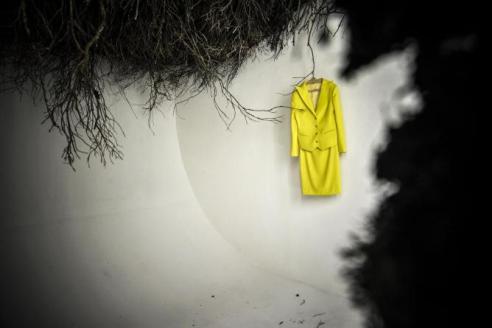
Petrit Halilaj, "I´m hungry to keep you close. I want to find the words to resist but in the end there is a locked sphere. The funny thing is that you´re not here, nothing is.," 2013. Various materials including birds, branches, earth, metal, clothes, dimensions variable. Courtesy the artist. Photo: Atdhe Mulla.
Padiglione Kosovo
55ª Esposizione Internazionale d'Arte - La Biennale di Venezia
Petrit Halilaj
I´m hungry to keep you close. I want to find the words to resist but in the end there is a locked sphere. The funny thing is that you´re not here, nothing is.
June 1–November 24, 2013
Arsenale Artiglierie
Calle Della Tana
2169/f Castello
30122 Venice
www.kosovopavilion.com
Commissioner: Erzen Shkololli
Curator: Kathrin Rhomberg
Under the patronage of Ministry of Culture, Youth and Sports of the Republic of Kosovo
Organization: National Gallery of Kosovo
Upon entering the space hosting the Kosovan contribution to the 55th Venice Biennial visitors find themselves abruptly confronted with a strange structure built, or rather woven, of branches, twigs and rods gathered in Kosovo, its ground and walls covered with soil and mud. Taking up almost two-thirds of the space, the structure seems an alien sight, an alien body, atavistic within the Biennial's context of contemporary art; a foreign body migrated from some subconscious and forgotten era or territory into a vicinity that is nothing less than a renowned icon of the historic western world's cultural and artistic achievements.
As if the grounds were not to be entirely trusted, the object—not unlike the landing module of some spaceship—is not rested firmly on the floor but slightly above it on supporting iron legs instead, designed in the form of bird feet. The object's detachment from the ground adds a certain ambiguity to its appearance, recalling vague ideas of some kind of primordial shelter or utopian spacecraft. Either way, there is an opening inviting those adventurous enough into the interior of the object.
With the musty, earthy smell intensified and the materiality of the object in branches and twigs far more tangible than when only contemplated from the outside, the narrow passageway reveals a hole in the wall, offering a peek into an interior space. This inner room's walls shine bright white, contrasting sharply with the darkness of the exterior. A contrast so striking that it lends the room the quality of a totally separated inner world, a 'mental space.' Its walls are not squared but rounded, their shape echoing the rounding of the object's outer surface.
Curiously enough, the space is also a home for two canaries, which lived until recently in the studio of the artist. The mismatch between the size of the space and that of the birds makes it questionable as to whether this space was conceived and built for them. Why do the canaries inhabit such a space? Were they brought here to sound an early warning of a coming crisis, like the danger they would forecast in coalmines? Whom are they warning? Unfit to survive when free in nature, easy prey in their colourfulness for any predator, the canaries are only imaginable as being shepherded by human beings. One wonders who he might be.
One also wonders to whom the dress and empty clothes hangers—randomly hung on the wall and in branches from the ceiling—belong? A sensation of absence and also transition is present. It is as if someone and something is no longer present, or has not yet returned, or has simply not yet arrived. Despite its obvious personal and intimate nature, the space evokes a longing for a perspective, for an outlook of future schemes and prospects—an almost utopian desire that might also speak of the shared experience that preceded this project for the Venice Biennale.
As in previous projects, Petrit Halilaj initiated an open process in which his family, friends and other people close to him were actively involved. Triggered by his mother´s suggestion to develop a shelter within a structure, which would free his project from the pressure to represent an entire nation, the artist pushed the collective experiences of all the invited contributors to the limit, transforming them together with his own memories of a rural childhood in Kosovo and his experiences of a life between different worlds, realities and ideologies, into art…"all while revealing the inevitable realities of a far wider sociopolitical sphere." (Elena Filipovic)
Petrit Halilaj's project is the starting point of Kosovo's first appearance at the Venice Biennale.
Biography
Petrit Halilaj, born 1986 in Skenderaj, Kosovo. Lives and works in Runik, Prishtina, Mantova and Berlin. Solo exhibitions (selected): WIELS, Contemporary Art Center, Brussels (2013); Who does the earth belong to while painting the wind?, Kunsthalle St. Gallen, St. Gallen (2012); Petrit Halilaj, Kunstraum Innsbruck, Innsbruck (2011); Back to the Future, Station, Prishtina (2009); Petrit Halilaj, Chert, Berlin (2009). Group exhibitions (selected): SUPER Visions – Zeichen und Sein, Museum Schloss Moyland, Bedburg-Hau (2013); New Public, Museion, Bolzano (2012); 30 Künstler 30 Räume, Kunstverein Nürnberg, Nürnberg (2012); Temoraneao, Nomas Foundation, Rome (2011); Ernste Tiere, Bonner Kunstverein, Bonn (2011); Ostalgia, New Museum, New York (2011); Based in Berlin, Berlin (2011); 6th Berlin Biennial for Contemporary Art, Berlin (2010).
The exhibition will be accompanied by a catalogue, co-published by the Verlag der Buchhandlung Walther König, Cologne. It includes essays by Erzen Shkololli, Kathrin Rhomberg, Shkelzen Maliqi and others.
Press contact: Nita Deda
nita.deda@kosovopavilion.com / T + 377 44 234 320


